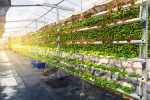Biochar is a stable, carbon-rich material created by heating organic biomass in a low-oxygen environment, a process known as pyrolysis. This method converts organic matter, such as agricultural waste, wood chips, or manure, into a charcoal-like substance. Biochar has numerous applications, especially in agriculture, where it is used to improve soil fertility, increase water retention, and reduce greenhouse gas emissions. Its porous structure and high surface area also make it effective in capturing carbon dioxide, contributing to carbon sequestration efforts.
Key Characteristics of Biochar
- Carbon-Rich: Biochar is primarily composed of carbon, making it a stable form of organic matter that can persist in the soil for hundreds to thousands of years.
- Porous Structure: Its microscopic pore structure provides a large surface area, ideal for retaining water, nutrients, and beneficial microorganisms.
- Alkaline pH: Depending on the feedstock and production temperature, biochar can have an alkaline pH, which can help to neutralize acidic soils.
Production of Biochar
The production of biochar involves several key steps:
- Selection of Biomass Feedstock:
- Types of Biomass: A wide range of organic materials can be used, including agricultural residues (corn stover, rice husks), forestry byproducts (wood chips, sawdust), manure, and even food waste.
- Feedstock Properties: The characteristics of the feedstock, such as its moisture content, chemical composition, and particle size, impact the final properties of the biochar.
- Preparation of Feedstock:
- Drying: Biomass must be dried to reduce moisture content, as too much moisture can hinder the pyrolysis process.
- Size Reduction: Large biomass particles are often shredded or ground into smaller pieces to increase surface area and improve heat transfer during pyrolysis.
- Pyrolysis Process:
- Low Oxygen Environment: Pyrolysis occurs in an oxygen-limited or oxygen-free environment to prevent complete combustion, which would convert the biomass into ash instead of biochar.
- Temperature and Residence Time:
- Low-Temperature Pyrolysis (300-500°C): Produces biochar with a higher volatile content and greater nutrient availability, often preferred for soil amendment.
- High-Temperature Pyrolysis (500-700°C): Produces a more stable, carbon-rich biochar with a lower volatile content, making it suitable for long-term carbon sequestration.
- Cooling and Collection:
- After pyrolysis, biochar is allowed to cool in an inert atmosphere to prevent oxidation. It is then collected, ground into finer particles if necessary, and stored for use.
- Activation (Optional):
- In some cases, biochar is “activated” to increase its porosity and surface area further. This can be achieved through physical (steam or CO₂ activation) or chemical methods (using activating agents like potassium hydroxide). Activated biochar is often used for filtration and remediation purposes.
Types of Pyrolysis Techniques
- Slow Pyrolysis:
- Description: Slow pyrolysis involves heating biomass at a moderate temperature (400-500°C) for a longer time (several hours).
- Products: This method prioritizes biochar production over bio-oil and syngas, yielding about 30-50% biochar from the biomass.
- Use: Ideal for producing biochar for soil applications due to the higher carbon content and stability.
- Fast Pyrolysis:
- Description: Fast pyrolysis heats biomass at a high temperature (450-600°C) for a short time (seconds to minutes), producing biochar, bio-oil, and syngas.
- Products: Yields more bio-oil and syngas, with biochar making up about 10-20% of the product.
- Use: Used in applications where bio-oil and syngas are also valuable byproducts, such as energy generation.
- Gasification:
- Description: Gasification heats biomass to a high temperature (>700°C) in a low-oxygen environment, primarily producing syngas (a mixture of hydrogen, carbon monoxide, and methane) and a small amount of biochar.
- Products: Yields primarily syngas with biochar as a byproduct.
- Use: Often used for energy production rather than biochar production, but the biochar byproduct can still be utilized.
Benefits of Biochar
- Soil Amendment:
- Improves soil structure by enhancing porosity and increasing water retention, especially beneficial in sandy or degraded soils.
- Boosts nutrient retention, reducing the leaching of fertilizers and increasing nutrient availability for plants.
- Carbon Sequestration:
- Biochar is a stable form of carbon, sequestering it in soil for hundreds to thousands of years, making it a significant tool for mitigating climate change.
- Pollutant Remediation:
- Its high adsorption capacity allows biochar to bind to heavy metals, organic pollutants, and excess nutrients, making it useful in soil and water remediation.
- Supports Soil Microbial Life:
- Biochar’s pore structure provides habitats for beneficial microorganisms that aid in nutrient cycling and plant health.
- Enhanced Crop Productivity:
- Biochar’s capacity to retain water and nutrients and support microbial life can result in improved crop yields, especially in nutrient-poor or water-limited environments.
Challenges in Biochar Production and Use
- Standardization:
- Biochar properties vary significantly based on feedstock type, pyrolysis conditions, and intended use. Standardization is needed to ensure consistent quality and effectiveness across applications.
- Cost of Production:
- Pyrolysis facilities and equipment can be costly, and while biochar production can be profitable, it often requires subsidies or high-value applications to be economically viable.
- Environmental Impacts:
- If not managed properly, the pyrolysis process can produce emissions of volatile organic compounds (VOCs) and particulate matter. However, these can be minimized with advanced technologies and emissions controls.
- Site-Specific Benefits:
- Biochar’s benefits depend on soil type, climate, and cropping systems. What works in one region or soil type may not yield the same results elsewhere.
Applications of Biochar
- Agriculture: Soil enhancement for crop production, livestock feed additive, manure management.
- Environmental Remediation: Treatment of contaminated soil and water, especially in areas affected by heavy metals or organic pollutants.
- Waste Management: Utilization of agricultural, forestry, or urban biomass waste, turning it into a value-added product.
- Climate Change Mitigation: Large-scale biochar applications could sequester carbon, potentially offsetting emissions from other sources.
Biochar is a versatile material with potential applications in agriculture, environmental remediation, and carbon sequestration. Its production through pyrolysis creates a carbon-stable product that offers various environmental benefits, such as enhancing soil quality, improving water retention, supporting microbial life, and capturing carbon for extended periods. Despite some challenges in production costs, standardization, and the need for site-specific studies, biochar has gained recognition as a promising solution in sustainable agriculture and environmental conservation efforts.


Leave a Reply